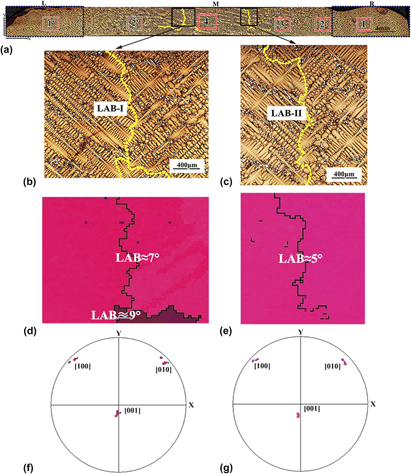Crossref Citations
This article has been cited by the following publications. This list is generated based on data provided by
Crossref.
Krawczyk, Jacek
Paszkowski, Robert
Bogdanowicz, Włodzimierz
Hanc-Kuczkowska, Aneta
Sieniawski, Jan
and
Terlecki, Bartosz
2019.
Defect Creation in the Root of Single-Crystalline Turbine Blades Made of Ni-Based Superalloy.
Materials,
Vol. 12,
Issue. 6,
p.
870.
Chen, Juan
and
Zhang, Lijun
2019.
Composition-dependent hardness and Young’s modulus in fcc Ni–X (X = Rh, Ta, W, Re, Os, and Ir) alloys: Experimental measurements and CALPHAD modeling.
Journal of Materials Research,
Vol. 34,
Issue. 18,
p.
3104.
Krawczyk, Jacek
Bogdanowicz, Włodzimierz
and
Sieniawski, Jan
2020.
The Number of Subgrain Boundaries in the Airfoils of Heat-Treated Single-Crystalline Turbine Blades.
Materials,
Vol. 14,
Issue. 1,
p.
8.
Xu, Wenliang
Wang, Fu
Ma, Dexin
Zhu, Xintao
Li, Dichen
and
Bührig-Polaczek, Andreas
2020.
Sliver defect formation in single crystal Ni-based superalloy castings.
Materials & Design,
Vol. 196,
Issue. ,
p.
109138.
Strickland, Joel
Tassenberg, Karl
Sheppard, Gareth
Nenchev, Bogdan
Perry, Sam
Li, Jun
Dong, Hongbiao
Burca, Genoveva
Kelleher, Joe
and
Irwin, Steve
2020.
2D single crystal Bragg-dip mapping by time-of-flight energy-resolved neutron imaging on IMAT@ISIS.
Scientific Reports,
Vol. 10,
Issue. 1,
Small, Kathryn A.
and
Taheri, Mitra L.
2021.
Role of Processing in Microstructural Evolution in Inconel 625: A Comparison of Three Additive Manufacturing Techniques.
Metallurgical and Materials Transactions A,
Vol. 52,
Issue. 7,
p.
2811.
Rafieazad, Mehran
Fathi, Parisa
Mohammadi, Mohsen
and
Nasiri, Ali
2021.
Effects of Laser-Powder Bed Fusion Process Parameters on the Microstructure and Corrosion Properties of AlSi10Mg Alloy.
Journal of The Electrochemical Society,
Vol. 168,
Issue. 2,
p.
021505.
Xiao, Jiuhan
Jiang, Weiguo
Han, Dongyu
Li, Kaiwen
Lu, Yuzhang
and
Lou, Langhong
2021.
Effect of the Spacial Dimensions on Solidification Defects in Rejoined Platform of Ni-Based Single-Crystal Superalloy Castings Under Different Withdrawal Rates.
Metallurgical and Materials Transactions A,
Vol. 52,
Issue. 7,
p.
2936.
Xiao, Jiu-han
Jiang, Wei-guo
Han, Dong-yu
Li, Kai-wen
Tong, Guo-jun
Lu, Yu-zhang
and
Lou, Lang-hong
2022.
Evolution mechanism of crystallographic orientation in grain continuator bars of a Ni-based single-crystal superalloy prepared by Bridgman technology during directional solidification.
China Foundry,
Vol. 19,
Issue. 1,
p.
35.
Chen, Chao
Sun, Jingxia
Diao, Aimin
Yang, Yanhong
Li, Jinguo
and
Zhou, Yizhou
2022.
On the dendrite deformation and evolution mechanism of Ni-based superalloy during directional solidification.
Journal of Alloys and Compounds,
Vol. 891,
Issue. ,
p.
161949.
Li, Guizhong
Sun, Dejian
Guo, Linfei
Yuan, Jingshu
Gao, Ka
Jie, Ziqi
Gao, Yang
and
Fan, Lei
2023.
Microstructure evolution and tensile behavior of hot pressed powder metallurgy superalloys.
Journal of Materials Research,
Vol. 38,
Issue. 17,
p.
4118.
Bao, Shuai
Yang, Chao
Li, Zhenshuai
Ye, Peiran
and
Chen, Yungui
2023.
Microstructure and Air Trace Defects of the Rapidly Solidified ZK60 Magnesium Alloy Ribbon.
Materials,
Vol. 17,
Issue. 1,
p.
30.
Liu, Minghao
Zeng, Qi
Zhang, Kai
Zhang, Huawei
Zheng, Wenpeng
Li, Yuanyuan
Hou, Juan
Wang, Jiangwei
Zhu, Yuman
and
Huang, Aijun
2023.
Revealing the interrelation between process parameters and microstructure to promote the mechanical performance for Hastelloy-X.
Vacuum,
Vol. 210,
Issue. ,
p.
111851.
Fan, Lei
Ran, Denglin
Bai, Yirui
Wang, Fatao
and
Yang, Neng
2024.
Study on casting simulation and wear properties of honeycomb configuration ZTAp-Fe composite.
Wear,
Vol. 538-539,
Issue. ,
p.
205188.
Qin, Jiarun
Yang, Wenchao
Wang, Qiang
Zhou, Yuhan
Fu, Haitao
Zhang, Jun
and
Liu, Lin
2024.
Orientation control of multiple single crystal blades using a novel high-throughput mold via seeding-grain selection technique.
Journal of Materials Research and Technology,
Vol. 29,
Issue. ,
p.
4845.
Wang, Fu
Liu, Yang
Yang, Qiang
Ma, Dexin
and
Li, Dichen
2024.
Microscale stray grains formation in single-crystal turbine blades of Ni-based superalloys.
Journal of Materials Science & Technology,
Vol. 191,
Issue. ,
p.
134.
Yang, Luwei
Ren, Neng
Li, Jun
Panwisawas, Chinnapat
Zhang, Yancheng
Xia, Mingxu
Dong, Hongbiao
and
Li, Jianguo
2025.
Thermal-solutal convection-induced low-angle grain boundaries in single-crystal nickel-based superalloy solidification.
Journal of Materials Science & Technology,
Vol. 208,
Issue. ,
p.
214.
Qin, Jiarun
Yang, Wenchao
Liu, Chen
Wang, Qiang
Xin, Zhao
Zhang, Yanchao
Liu, Yang
Su, Haijun
and
Liu, Lin
2025.
Secondary orientation effect of the platform defects in [001] oriented single crystal blades prepared by high-throughput mold.
Journal of Materials Research and Technology,
Vol. 37,
Issue. ,
p.
4362.
Rajabinejad, Sobhan
Yazdani, Javad
Fouladvand, Majid
and
Yazdi, Mohammad-Reza Ahmadpour
2025.
A review of sliver defects in Ni-based single crystal superalloys.
China Foundry,
Xu, Qiao zhi
Zhang, Si qian
Zhou, Ge
Zhang, Hao yu
Wang, Dong
and
Chen, Li jia
2025.
Effect of Low-Angle Grain Boundaries on Tensile Properties of a Nickel-Based Superalloy at 900 °C.
Journal of Materials Engineering and Performance,


